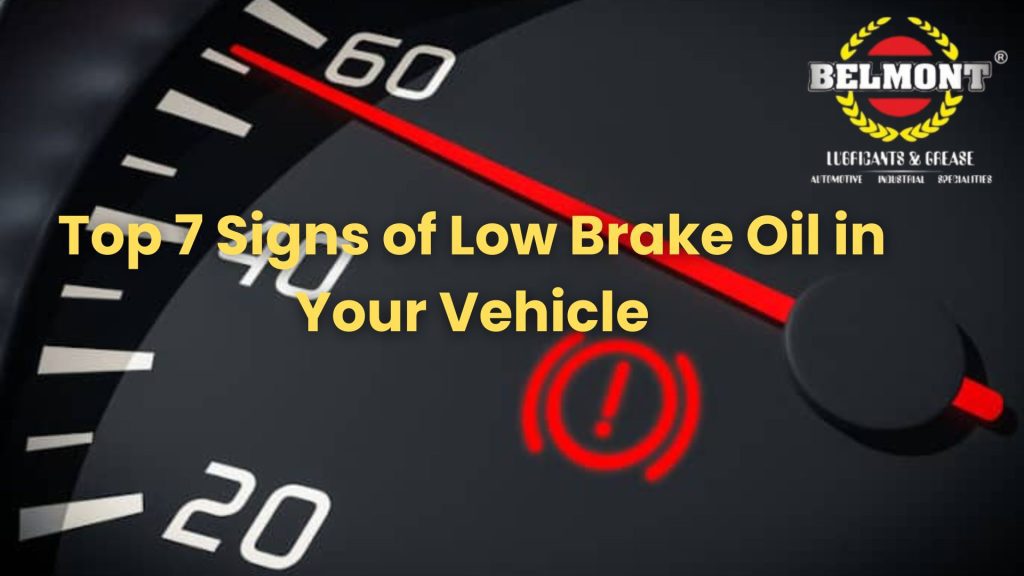
Brake oil, also known as brake fluid, is one of the most critical yet often overlooked components in your vehicle. Understanding the Top 7 Signs of Low Brake Oil in Your Vehicle is essential, as this fluid plays a vital role in transmitting the force from the brake pedal to the braking system. Without sufficient brake oil, your vehicle’s braking efficiency drops significantly, increasing the risk of accidents.
Many drivers fail to recognize the early warning signs of low brake oil, leading to costly repairs or even brake failure. In this article, we’ll cover the top 7 signs of low brake oil in your vehicle and explain why timely maintenance is essential for safe driving.
Why Brake Oil Is Important for Your Vehicle
Brake oil acts as the lifeblood of the braking system. It not only transfers pressure but also lubricates components, prevents corrosion, and maintains consistent braking performance under high temperatures. When the fluid level drops, air can enter the system, causing a loss of hydraulic pressure.
That’s why keeping your brake fluid at the right level with high-quality lubricants from trusted suppliers like Belmont Lubricants is essential for both safety and performance.
Top 7 Signs of Low Brake Oil in Your Vehicle
1. Spongy or Soft Brake Pedal
If your brake pedal feels unusually soft, spongy, or sinks too far when pressed, it is a clear sign of low brake oil in your vehicle. This happens because the hydraulic pressure weakens, reducing stopping power.
2. Brake Warning Light on Dashboard
Modern cars have a sensor that detects low brake fluid levels. If the brake warning light turns on, it’s a serious indication that your vehicle needs immediate attention.
3. Longer Stopping Distances
When there isn’t enough brake fluid, the braking system fails to generate adequate pressure. As a result, your car takes longer to stop, increasing the risk of accidents.
4. ABS (Anti-lock Braking System) Warning Light
Vehicles equipped with ABS may show a separate ABS light when fluid levels drop. Since ABS requires precise hydraulic pressure, low brake fluid disrupts its functioning.
5. Unusual Noises While Braking
Grinding, squealing, or hissing noises while braking may not always mean worn-out pads. Sometimes, these are symptoms of low brake oil, which prevents smooth operation.
6. Fluid Leaks Under the Vehicle
If you notice a puddle of oily liquid under your car—particularly near the wheels or under the brake master cylinder—it could be brake fluid leakage. Leaks directly cause low brake oil levels.
7. Burning Smell After Braking
An unusual burning odor after frequent braking can also indicate overheating caused by insufficient brake fluid lubrication.
What Causes Low Brake Oil in Your Vehicle?
- Worn brake pads or shoes – As pads wear down, more fluid is needed to fill the caliper cylinder.
- Leaks in the brake lines – Damaged or corroded brake lines allow fluid to escape.
- Faulty master cylinder – A failing master cylinder can cause gradual loss of brake fluid.
- Poor maintenance – Skipping regular brake fluid checks and changes leads to problems.
How to Check Brake Oil Levels
- Park the car on a flat surface and switch off the engine.
- Lift the car’s hood and find the brake master cylinder reservoir, usually located near the back of the engine bay on the driver’s side.
- Ensure the fluid level is between the MIN and MAX marks.
- If the level is low, top up with the manufacturer-recommended DOT 3, DOT 4, or DOT 5.1 brake fluid.
Always use high-quality lubricants from reliable suppliers such as:
Why You Shouldn’t Ignore Low Brake Oil Symptoms
Driving with low brake oil is extremely dangerous. It reduces braking efficiency, damages braking components, and can lead to total brake failure. Timely refilling and regular brake system inspection can save you from accidents and costly repairs.
At Belmont, we manufacture premium-grade brake fluids, engine oils, gear oils, and greases suitable for both automotive and industrial applications. Our products are trusted across India and international markets for consistent performance.
Related Reads You May Find Helpful
- Symptoms of Low Coolant in Car While Driving: Complete Guide 2025
- Can I Use ATF Oil as Power Steering Fluid? Expert Guide 2025
- What Happens If You Use Normal Engine Oil in a CNG Car?
These articles cover other common vehicle fluid-related issues that every driver should know.
FAQs on Signs of Low Brake Oil in Your Vehicle
Q1. What happens if brake oil is low in a vehicle?
Low brake oil reduces hydraulic pressure, causing soft pedals, longer stopping distance, and potential brake failure.
Q2. How often should brake oil be changed?
Most experts recommend changing brake fluid every 2 years or 30,000–40,000 km, depending on driving conditions.
Q3. Can I drive with low brake fluid?
No. Driving with low brake fluid is unsafe and can lead to complete brake failure.
Q4. Which brake oil is best for Indian vehicles?
DOT 3 and DOT 4 brake oils are widely used in India. Always check the manufacturer’s recommendation before refilling.
Q5. How do I know if my brake oil is leaking?
Look for fluid puddles under the car, soft brake pedals, and warning lights on the dashboard.
Final Thoughts
Recognizing the Top 7 Signs of Low Brake Oil in Your Vehicle is essential for safe driving. From spongy brake pedals to warning lights on your dashboard, these symptoms should never be ignored. Regular brake system inspections and timely fluid top-ups with premium lubricants from trusted suppliers like Belmont Lubricants help ensure maximum safety and optimal performance.
If you want reliable brake oils, engine oils, and greases for cars, trucks, and heavy-duty vehicles, visit:
Stay safe, maintain your vehicle, and never ignore the small warning signs that keep you and your passengers secure on the road.
